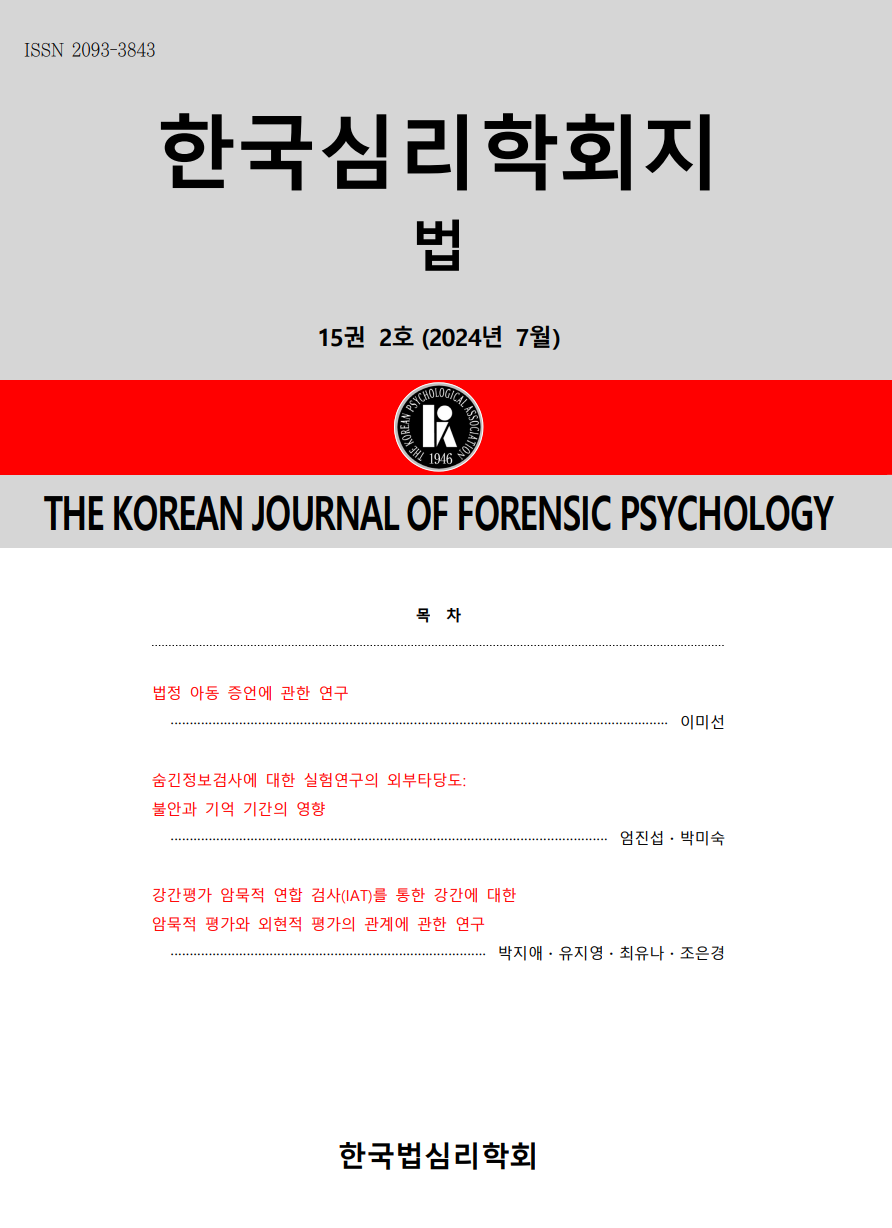open access
메뉴
open access
메뉴 ISSN : 2093-3843
ISSN : 2093-3843
This study classifies elder abuser into subtypes based on their profiles. 69 cases with abusers’ demographics, harmful characteristics, and abuse behaviors were retrieved from case books published by government agencies. Latent class analysis was used to categorize abusers based on 11 variables. Result showed that abusers fall into 4 profiles descriptively labeled “Mental disordered”, “stress explosive”, “dependent”, “economical burden” types. This result revealed abuser subtypes which are not able to be identified by analysis of abusing behaviors. Discussion and future research direction are discussed.
강은나, 이민홍 (2014). 시설거주노인의 사회적네트워크 유형에 관한 탐색적 연구. 보건사회연구, 34(2), pp.133-160.
고보선, 유용식 (2004). 노인학대 유형별 대처전략에 관한 연구 - 개인적 위험요인을 중심으로. 노인복지연구, 23(0), 83-105.
김미혜, 권금주, 임연옥, 이연호 (2006). 노인학대 측정 도구: 학대유형과 심각성을 중심으로. 한국노년학, 26(4), 819-842.
김사현, 홍경준 (2010). 잠재계층분석방법을 통한 서울시민의 복지태도 연구. 사회복지정책, 37(2), pp.95-121.
김수영, 김명일, 장수지, 문경주 (2017). 잠재계층분석(Latent Class Analysis)을 활용한 한국노인의 건강증진행위 유형화와 영향요인분석. 보건사회연구, 37(2), 251-286.
김윤정, 이기학 (2009). 학대받는 노인의 유형별 특성 및 삶의 질 향상 방안. 한국노년학, 29(2), 459-475.
김태현, 한은주 (2000). 노인학대의 원인에 대한생태학적 연구. 한국노년학, 20(2), 71-89.
배진희, 정미순 (2008). 노인이 인식한 가해자특성이 노인학대에 미치는 영향. 한국노년학, 28(3), 443-457.
윤정숙, 송원역 (2017). 노인학대행위자 상담, 교육 커리큘럼 개발. 중앙노인보호전문기관연구용역보고서.
윤현숙, 권종희, 윤지영, 박은수, 남륜, 강성보, 박금화 (2010). 노인학대 인식과 도움요청태도에 관한 연구: 여섯 가지 노인학대시나리오를 중심으로. 한국노년학, 30(1), 221-240.
이미진, 김혜련 (2016). 노인학대유형별 노인 및 학대행위자 특성 비교: 노인보호전문기관의 노인학대사례 분석. 노인복지연구, 71(3), 53-89.
이윤경, 김미혜 (2008). 노인학대 유형화 및 유형결정요인 연구. 한국노년학, 28(4), 1165-1178.
정수일, 박미란 (2016). 산업진흥교육: 노인 학대의 유형별 분류에 관한 연구. 산업진흥연구, 1(1), 91-103.
조영일 (2018). 잠재계층분석의 소개와 심리학연구에서의 활용. 한국심리학회 학술대회자료집, 202-202.
중앙노인보호전문기관 (2018). 2017년 노인학대 현황보고서.
한동희, 김정옥 (1994). 노인학대에 관한 이론적 고찰. 대한가정학회지, 32(4), 45-56.
Choi, N. G., & Mayer, J. (2000). Elder Abuse, Neglect, and Exploitation. Journal of Gerontological Social Work, 33(2), 5-25
DeLiema, M., Yonashiro-Cho, J., Gassoumis, Z. D., Yon, Y., & Conrad, K. J. (2017). Using latent class analysis to identify profiles of elder abuse perpetrators. The Journals of Gerontology: Series B, 73(5), e49-e58.
Gordon R. M., Brill D. (2001) The Abuse and Neglect of the Elderly. In: Weisstub D. N., Thomasma D. C., Gauthier S., Tomossy G. F. (eds) Aging: Caring for Our Elders. International Library of Ethics, Law, and the New Medicine, vol 11. Springer, Dordrecht.
Huang, L., Dziak, J. J., Wagner, A. T., & Lanza, S. T. (2016). LCA bootstrap Stata function users’ guide (Version 1.0). University Park:The Methodology Center, Penn State. Retrieved from
Jackson, S. L. (2014). All elder abuse perpetrators are not alike: The heterogeneity of elder abuse perpetrators and implications for intervention. International Journal of Offender Therapy and Comparative Criminology, 60, 265-285.
Jedidi, K., Ramaswamy, V., & DeSarbo, W. S. (1993). A maximum likelihood method for latent class regression involving a censored dependent variable. Psychometrika, 58(3), pp.375-394.
Lachs, M. S., & Pillemer, K. (2004). Elder abuse. The Lancet, 364(9441), 1263-1272.
National Research Council. (2003). Elder Mistreatment: Abuse, Neglect, and Exploitation in an Aging America. Panel to Review Risk and Prevalence of Elder Abuse and Neglect. Washington, DC: The National Academies Press.
Nylund, K.L., Asparouhov, T., & Muthen, B. (2007). Deciding on the number of classes in latent class analysis and growth mixture modeling. A Monte Carlo simulation study. Structural Equation Modeling, 14, 535-569.
Oberski D. (2016) Mixture Models: Latent Profile and Latent Class Analysis. In: Robertson J., Kaptein M. (eds) Modern Statistical Methods for HCI. Human-Computer Interaction Series. Springer, Cham.
Ramsey-Klawsnik, H. (2000). Elder abuse perpetrators: A typology. Generations, 24, 7-22.
Tueth, M. J. (2000). Exposing fnancial exploitation of impaired elderly persons. The American Journal of Geriatric Psychiatry, 8, 104-111.
UCLA: Statistical Consulting Group. (accessed March 22, 2018). Introduction to SAS. Retrieved from https://stats.idre.ucla.edu/mplus/dae/latent-class-analysis
Wallace, H. (2005). Family violence: Legal, medical and social perspectives (4th ed.). New York, NY: Pearson Education Inc.
Wurpts, I. C., & Geiser, C. (2014). Is adding more indicators to a latent class analysis beneficial or detrimental? Results of a Monte-Carlo study. Frontiers in psychology, 5, 920.